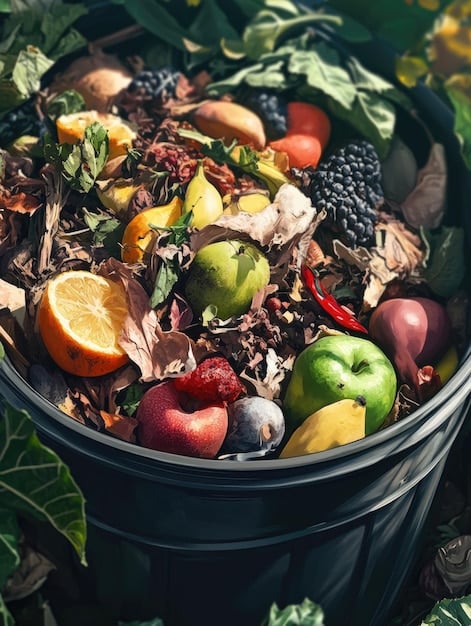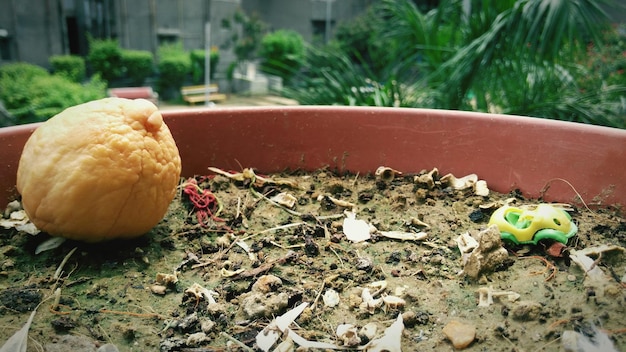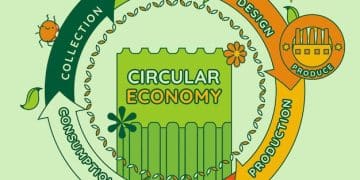How US Households Can Cut Food Waste by 25% with Composting by 2025

Achieving a 25% reduction in US household food waste by 2025 through composting is feasible by integrating accessible composting methods, offering clear educational resources, and fostering community-driven initiatives that encourage widespread adoption of sustainable waste diversion practices.
In the pursuit of a more sustainable future, a critical question emerges: How can US households reduce food waste by 25% in 2025 through composting? This ambitious yet achievable goal holds the potential to significantly lessen environmental impact, conserve resources, and even save money. As we look towards 2025, the role of composting in transforming our collective approach to food waste becomes increasingly clear, paving the way for healthier homes and a healthier planet.
The Hidden Impact of Food Waste in US Households
Food waste is not merely an unsightly inconvenience; it represents a profound environmental, economic, and social challenge. In the United States, a staggering amount of food goes uneaten each year, contributing significantly to landfill emissions and squandering valuable resources. Understanding the true scale of this issue is the first step toward effective mitigation and embracing solutions like composting.
From the farm to our forks, inefficiencies and consumer habits lead to billions of pounds of edible food being discarded. This waste often ends up in landfills, where it decomposes anaerobically—without oxygen—producing methane, a potent greenhouse gas far more impactful than carbon dioxide over the short term. The implications extend beyond climate change, touching upon water usage, land degradation, and the unnecessary expenditures associated with producing, transporting, and disposing of food that never fulfills its purpose.
Environmental Consequences of Food Waste
The environmental footprint of food waste is immense. When we throw away food, we’re not just discarding a meal; we’re discarding all the resources that went into producing it. This includes vast quantities of water used for irrigation, energy consumed in farming and transportation, and the land dedicated to cultivation. Furthermore, the decomposition of organic matter in landfills releases harmful gases, exacerbating climate change and contributing to air pollution. The ripple effect touches biodiversity, soil health, and water quality.
- Greenhouse Gas Emissions: Landfilled food waste generates methane, a powerful contributor to global warming, accelerating climate change.
- Resource Depletion: The production of wasted food consumes precious water, land, and energy, straining natural resources unnecessarily.
- Pollution: Leachate from landfills can contaminate groundwater, while transport of waste increases carbon emissions.
Economic and Social Dimensions
Beyond the environmental toll, food waste carries a substantial economic burden for households and the nation. Families spend money on food they ultimately discard, representing a direct financial loss. At a national level, the costs associated with waste management, including collection and landfilling, are considerable. Moreover, it creates a stark paradox: large quantities of food are wasted while millions of Americans face food insecurity. Bridging this gap through better food management and diversion strategies can address both environmental concerns and social inequities.
By understanding the multifaceted impact of food waste, US households can begin to recognize the urgency and importance of adopting practices that minimize their footprint. Composting emerges as a powerful, localized solution, turning a problematic waste stream into a valuable resource, thus contributing to a more circular and sustainable economy. The shift in perspective from “waste” to “resource” is fundamental for achieving the ambitious 25% reduction goal by 2025.
Our consumption patterns and disposal habits directly influence the severity of this issue. Educating ourselves and implementing simple, yet effective, actions at home can collectively lead to a significant positive change. This holistic understanding reinforces why composting is not just a trend but a vital component of a resilient and environmentally conscious lifestyle. Reducing food waste effectively means confronting these interwoven challenges head-on.
The Power of Composting: A Core Solution for 2025
Composting stands as a remarkably effective and accessible method for diverting organic waste from landfills, offering a tangible pathway to achieving significant reductions in household food waste. It transforms kitchen scraps and yard trimmings into nutrient-rich soil amendment, benefiting gardens and landscapes while simultaneously mitigating environmental harm. The simplicity and versatility of composting make it an ideal strategy for widespread adoption across US households, providing a powerful tool in the fight against waste.
The process of composting involves the natural decomposition of organic materials by microorganisms under controlled conditions. This accelerates the natural decay process, breaking down food scraps and other biodegradables into humus—a dark, earthy, nutrient-dense material. This “black gold” can then be used to enrich soil, improving plant growth and reducing the need for chemical fertilizers. By embracing composting, households actively participate in a circular economy, returning valuable nutrients to the earth.
Understanding Composting Basics
Successful composting hinges on a few fundamental principles: a balanced mix of “greens” (nitrogen-rich materials like food scraps and grass clippings) and “browns” (carbon-rich materials like dry leaves, shredded paper, and wood chips), adequate moisture, and proper aeration. Maintaining this balance ensures rapid decomposition and prevents odor issues. While various composting methods exist, from simple backyard piles to sophisticated indoor systems, the core principles remain consistent, making it adaptable to diverse living situations.
- Greens (Nitrogen): Provide essential nutrients for microorganisms; include fruit/vegetable scraps, coffee grounds, tea bags, grass clippings.
- Browns (Carbon): Offer energy for decomposers; consist of dry leaves, shredded paper/cardboard, wood chips, and sawdust.
- Moisture and Air: Crucial for microbial activity; ensure the pile is damp like a wrung-out sponge and turned regularly for aeration.
Methods of Composting for US Homes
The beauty of composting lies in its adaptability. For homes with outdoor space, backyard composting bins or open piles are popular choices. These methods handle larger volumes of waste and produce finished compost relatively quickly. For urban dwellers or those with limited outdoor areas, indoor composting solutions such as vermicomposting (using worms) or electric kitchen composters offer viable alternatives. Each method has its unique advantages, allowing households to select the system that best fits their lifestyle and space constraints.
Backyard composting typically involves a well-ventilated bin or a designated area in the yard. This method is excellent for processing both food scraps and yard waste. Vermicomposting, a more contained indoor option, uses specific types of worms to break down food waste into rich castings. Electric kitchen composters offer a quick, odorless way to turn food waste into a soil amendment, often within hours. The availability of these diverse methods means that almost every US household can find a composting solution that works for them, empowering them to take direct action against food waste.
Ultimately, widespread adoption of composting is not just about waste diversion; it’s about shifting our relationship with waste itself. It fosters a greater appreciation for natural cycles and encourages a more mindful approach to consumption. By actively participating in composting, US households contribute to a noticeable reduction in landfill waste, enhance local soil health, and exemplify a commitment to environmental stewardship. The collective power of these individual actions can indeed put us on track to meet the 25% reduction target by 2025.

Strategies for Achieving a 25% Reduction by 2025
To reach the ambitious goal of a 25% reduction in US household food waste through composting by 2025, a multi-faceted approach is essential. This requires a combination of individual action, community support, and systemic encouragement. The challenge is significant, but with concerted effort and widespread adoption of best practices, it is entirely within reach. The strategies outlined here focus on making composting accessible, understandable, and an integral part of daily life for millions of Americans.
One primary strategy involves demystifying composting. Many individuals perceive it as complex or messy, deterrents that can be overcome through clear, practical guidance. Providing accessible resources—whether online tutorials, community workshops, or user-friendly guides—can empower even novices to begin composting with confidence. Equally important is fostering a sense of community and collective responsibility, demonstrating that small individual actions accumulate into significant environmental benefits. This calls for a collaborative effort from various stakeholders.
Educating and Empowering Households
Effective education is paramount. Households need to understand not only how to compost but also why it matters. Information should cover simple “do’s and don’ts” for compostable materials, tips for managing common issues like odors, and the environmental benefits of diverting food waste. Hands-on workshops, webinars, and accessible online content can be tailored to different learning styles and demographic groups. Marketing campaigns highlighting the ease and benefits of composting can also play a crucial role in shifting public perception.
- Direct Education: Organize community workshops, online courses, and local demonstrations on composting techniques.
- Accessible Resources: Create easy-to-understand infographics, videos, and guides for diverse audiences.
- Benefit Communication: Highlight both environmental and economic benefits of composting to motivate households.
Facilitating Access and Infrastructure
Expanding access to composting infrastructure is critical, particularly for households without the space or desire for home composting. This includes increasing the availability of municipal composting programs, community drop-off sites, and private curbside collection services. Partnerships between local governments, private waste haulers, and community organizations can help establish and scale these services. Subsidies or incentives for composting bins and services could also encourage greater participation, making composting a convenient and affordable option for all.
For example, some municipalities have introduced “green bin” programs for organic waste collection, making it as easy as recycling. Others have established centralized community composting sites where residents can drop off their food scraps. These programs not only divert waste but also often create local jobs and produce valuable compost for public parks or community gardens. Removing logistical barriers is key to achieving widespread adoption, ensuring that households, regardless of their living situation, can participate actively in reducing food waste. This requires a coordinated effort between policy makers, waste management organizations, and advocacy groups.
Ultimately, achieving a 25% reduction requires a cultural shift—one where composting is seen not as a niche activity but as a fundamental aspect of sustainable living. By combining robust education, accessible infrastructure, and supportive policies, US households can collectively make a profound impact on food waste reduction by 2025. This integrated approach ensures that every household has the knowledge, tools, and opportunities to make composting a routine part of their efforts towards environmental responsibility.
Overcoming Challenges and Common Misconceptions
While the benefits of composting are clear and the goal of reducing food waste by 25% is compelling, widespread adoption isn’t without its challenges. Households often face practical hurdles or hold common misconceptions that prevent them from embracing composting. Addressing these barriers directly is crucial for scaling up composting efforts and ensuring that the 2025 target remains achievable. Transparency and practical solutions are key to demystifying the process and encouraging participation.
One of the primary concerns for many prospective composters is the fear of odors or pests. These issues, while sometimes occurring, are typically a sign of an improperly managed compost pile. By providing clear guidance on balancing “greens” and “browns,” ensuring adequate aeration, and avoiding certain problematic materials (like meat and dairy in backyard piles), these concerns can be largely mitigated. Educating households on these simple management techniques can alleviate anxiety and promote successful composting experiences.
Addressing Odors and Pests
Many households hesitate to compost due to concerns about unpleasant smells or attracting unwanted critters. These problems are almost always a result of an imbalance in the compost pile. Too many “greens” (food scraps) can lead to anaerobic decomposition, producing methane and foul odors. Insufficient browns or poor aeration can also contribute. Proper layering and aeration are simple solutions.
- Balance Greens and Browns: Ensure a 2:1 ratio of browns to greens to prevent anaerobic conditions and odors.
- Aerate Regularly: Turn your compost pile or container frequently to introduce oxygen, crucial for aerobic decomposition.
- Avoid Problematic Items: For most home composting, avoid meat, dairy, oily foods, and pet waste, which can attract pests and create odors.
Space Constraints and Urban Living
Another common challenge, particularly in urban areas, is the perceived lack of space for a compost bin. However, composting is highly adaptable. Small-scale solutions like worm bins (vermicomposting) are ideal for apartments and small homes, requiring minimal space and producing excellent compost. Electric kitchen composters also offer a compact, indoor solution that rapidly processes food waste. Community composting programs or drop-off sites provide alternatives for those unable to compost at home, ensuring that space is no longer an insurmountable barrier.
The key to overcoming these challenges lies in providing tailored information and promoting a diversity of composting methods. By showcasing successful examples from various living situations and offering practical troubleshooting tips, more households will feel confident in starting their composting journey. Addressing misconceptions through factual information and supporting initial efforts can turn skepticism into success stories, contributing significantly to the overall reduction goals. This supportive approach fosters resilience and innovation among new composters.
Furthermore, local government initiatives, such as providing discounted composting bins or organizing educational workshops, can significantly lower the barrier to entry. Peer-to-peer learning and community composting mentors can also offer invaluable support, guiding new composters through their initial experiences. By proactively tackling these common obstacles, we can ensure that composting becomes a widespread, habitual practice for US households, accelerating progress towards the 25% food waste reduction target by 2025.
Benefits Beyond Waste Reduction: Soil Health & Community Impact
While the primary objective of composting food waste is to reduce landfill contributions, its benefits extend far beyond a cleaner waste stream. Composting offers profound advantages for soil health, enhances local ecosystems, and fosters stronger, more resilient communities. Understanding these broader impacts can serve as an additional powerful motivator for US households to adopt and diligently maintain composting practices, reinforcing its value as a holistic environmental strategy.
The “black gold” produced from composting is not just decomposed organic matter; it’s a living, breathing amendment that revitalizes soil, making it more fertile and productive. This directly supports local gardening efforts, reduces reliance on chemical fertilizers, and improves the overall ecological health of our surroundings. When households compost, they are not only diverting waste but actively participating in the regeneration of natural resources, creating a virtuous cycle of sustainability that benefits everyone.
Restoring and Enriching Soil Health
The most immediate and tangible benefit of composting is its positive impact on soil. Compost improves soil structure, enhancing its ability to retain water and nutrients. It also introduces beneficial microorganisms that break down organic material, making nutrients available to plants. This leads to healthier, more robust plant growth, whether in backyard gardens, potted plants, or community green spaces. By enriching the soil with compost, households contribute to local food security and reduce the need for synthetic chemical inputs, which can harm the environment.
- Improved Soil Structure: Compost lightens heavy clay soils and adds body to sandy soils, improving drainage and aeration.
- Increased Water Retention: Organic matter in compost acts like a sponge, helping soil hold more moisture, reducing the need for frequent watering.
- Nutrient Provision: Compost provides a slow-release source of essential plant nutrients, fostering healthier plant growth naturally.
Fostering Community Engagement and Resilience
Composting initiatives can also serve as catalysts for community building. Community composting sites bring neighbors together, fostering shared responsibility and environmental stewardship. Workshops and educational programs on composting provide opportunities for learning and social interaction. Moreover, diverting food waste from landfills reduces the burden on municipal waste systems, contributing to local fiscal health and freeing up resources for other community-focused projects. This collective action builds resilience and strengthens local bonds.
Community gardens flourishing with composted soil often become vibrant hubs, connecting residents and providing access to fresh produce. The act of composting, whether individually or as part of a collective, subtly reinforces the interconnectedness of our actions with the environment and our neighbors. It transforms a mundane task into a meaningful contribution, cultivating a sense of pride and shared purpose. These social and ecological dividends make composting an investment not just in waste reduction, but in creating more vibrant, self-sufficient, and environmentally conscious communities.
By highlighting these broader benefits, we can motivate a wider segment of the US population to embrace composting not just as a waste management technique, but as a lifestyle choice that deeply enriches both their personal environment and the collective well-being. The 25% reduction target by 2025 becomes not merely a quantitative goal, but a testament to a shift towards a more symbiotic relationship with our planet.
Policy and Technological Innovations Supporting Composting
Achieving a 25% reduction in US household food waste by 2025 through composting demands more than just grassroots efforts; it requires a supportive framework of policy and a continuous influx of technological innovation. Governments, at all levels, and private sector innovators play a crucial role in creating an environment where composting is not just an option, but an accessible and encouraged practice. These advancements and mandates can significantly accelerate the adoption rate and scale of composting across the nation.
Policy initiatives, such as mandatory composting programs or financial incentives, can dramatically shift household behavior. Simultaneously, new technologies are making composting easier, faster, and more suitable for diverse living situations. From smart composting bins to improved collection logistics, technology is continually refining the process, addressing common barriers, and making it more appealing for the average household. The synergistic relationship between policy and technology is key to reaching the ambitious 2025 target.
Government Policies and Incentives
Several states and municipalities in the US have already implemented policies to encourage or mandate organic waste diversion. These range from bans on organic waste in landfills to curbside collection programs and grants for community composting initiatives. Such policies not only reduce landfill burden but also create jobs in the composting industry. Federal incentives, research funding, and educational campaigns could further amplify these local successes, driving nationwide adoption.
- Organic Waste Bans: Legislation prohibiting food scraps from landfills encourages alternative disposal methods like composting.
- Curbside Collection Programs: Municipal services that pick up organic waste alongside recycling and trash, simplifying the process for residents.
- Financial Incentives: Tax breaks, grants, or rebates for purchasing composting equipment or participating in compost programs.
Technological Advancements in Composting
Innovations in composting technology are making the process more efficient, user-friendly, and adaptable to various housing types. Electric kitchen composters reduce food waste volume by up to 90% in a matter of hours, largely eliminating concerns about odors and pests. Smart composting bins with embedded sensors can monitor moisture and temperature, providing real-time data to optimize the decomposition process. Furthermore, advancements in large-scale industrial composting facilities are improving their capacity and efficiency, supporting broader municipal programs.
The development of anaerobic digesters, for instance, can not only process organic waste but also capture methane emissions to generate renewable energy, turning waste into a resource. Innovations in compostable packaging also indirectly support composting efforts by reducing contamination in organic waste streams. These technological leaps are crucial for scaling up composting operations, making them more economical and effective for urban and rural settings alike. By investing in and promoting both robust policies and cutting-edge technologies, the US can rapidly advance its food waste reduction goals, ensuring that composting plays a central role in a sustainable future. Collaboration between public and private sectors will be paramount in deploying these solutions effectively.
The combined force of supportive governmental policies and continuous technological innovation creates a powerful impetus for change. These elements provide the necessary framework and tools to empower US households to adopt composting on an unprecedented scale. As we approach 2025, maximizing the reach and effectiveness of these strategies will be paramount for not just meeting, but potentially exceeding, the 25% food waste reduction target through composting.
Future Outlook: Sustaining Momentum Beyond 2025
Achieving a 25% reduction in US household food waste by 2025 through composting is an ambitious but attainable goal. However, sustaining this momentum and continuing to build upon these successes beyond 2025 is equally crucial. The journey towards a truly circular and zero-waste economy is ongoing, requiring continuous effort, adaptation, and innovation. The future outlook for composting involves integrating it even more deeply into our societal fabric, fostering a permanent shift in how households perceive and manage organic waste.
This long-term vision encompasses not just expanding composting programs but also nurturing a culture valuing food, minimizing waste at its source, and embracing natural resource cycles. It means evolving educational programs, adapting policies to meet changing needs, and leveraging emerging technologies to make composting even more seamless and impactful. The foundations laid by 2025 will serve as a springboard for further advancements, ensuring that food waste reduction remains a national priority.
Integrating Composting into Daily Life
The ultimate goal is for composting to become as routine and ubiquitous as recycling. This involves not only making it logistically easy but also cultivating a mindset where separating food scraps for composting is second nature. Educational efforts need to evolve, targeting younger generations in schools and integrating sustainable practices into community planning. Public-private partnerships can explore innovative collection models and infrastructure development, making composting universally accessible regardless of geographic location or housing type.
Further research into the most effective public awareness campaigns and behavior change strategies will be vital. Encouraging home composting, supporting community gardens that utilize local compost, and promoting restaurants and businesses that divert their food waste can all contribute to a comprehensive eco-system of waste reduction. By making composting an easy and rewarding daily habit, its longevity and impact beyond 2025 are secured. This cultural shift is perhaps the most profound and lasting outcome of achieving initial reduction targets.
Continuous Innovation and Policy Evolution
To maintain momentum, continuous innovation in composting technology and ongoing evolution of supportive policies will be necessary. This includes researching more efficient decomposition methods, developing better odor control technologies, and refining large-scale composting operations to reduce their environmental footprint. Policy frameworks will need to adapt, potentially introducing stronger incentives for businesses and larger institutions to divert organic waste, extending the reach of composting beyond individual households.
Furthermore, integrating food waste reduction and composting into broader climate action plans and sustainability initiatives will elevate its importance and secure funding for future endeavors. Regular assessments of progress, identification of new challenges, and sharing of best practices across communities will be essential for sustained growth. The ambition to reduce food waste is a long-term commitment, and the groundwork laid for 2025 will define the trajectory for generations to come, creating a more resilient and sustainable food system for the entire nation.
By fostering a culture of continuous improvement and adaptation, the US can go beyond simply reducing food waste by 25% by 2025. It can establish a lasting legacy of environmental stewardship, where composting is a fundamental pillar of sustainable living, securing a healthier planet for future generations while bolstering local economic and ecological systems.
| Key Aspect | Brief Description |
|---|---|
| 🍎 Food Waste Impact | US households waste enormous food, contributing to landfills, methane emissions, and resource depletion. |
| 🌱 Composting Solution | Transforms organic waste into nutrient-rich soil, diverting waste and improving soil health. |
| 🚀 2025 Reduction Goal | Achievable via education, diverse composting methods, and supportive community/policy initiatives. |
| 🏡 Home & Policy Support | Addressing common challenges like odor/space, backed by effective policies and technological innovation. |
Frequently Asked Questions About Composting and Food Waste
Food waste refers to edible food that is discarded instead of being consumed. In the US, it’s a significant problem because it accounts for a large portion of landfill waste, where it generates methane, a potent greenhouse gas. This also represents a massive waste of resources like water, land, and energy used to produce the food, and contributes to economic losses for households.
Composting transforms organic materials like food scraps into nutrient-rich soil amendment (compost) through natural decomposition. By doing so, it diverts these materials from landfills, preventing methane emissions. Instead, the organic matter enriches soil, improving fertility and reducing the need for chemical fertilizers, creating a beneficial closed-loop system.
Starting small is key. For outdoor space, a simple backyard bin or pile works well. For apartments, vermicomposting (worm composting) or electric kitchen composters are excellent indoor options. Look for local municipal composting programs or community drop-off sites if home composting isn’t feasible, making it accessible for almost any household.
Absolutely. While ambitious, a 25% reduction is achievable through widespread adoption of composting. This requires concerted efforts in public education, making composting infrastructure more accessible, and implementing supportive policies and incentives. Collective household participation, even with small-scale composting, can lead to significant national impact.
Beyond diverting waste, composting dramatically enriches soil, improving its structure, water retention, and nutrient content, which benefits gardens and reduces reliance on chemical fertilizers. It also fosters community engagement, supports local ecosystems, and contributes to a more circular economy by returning valuable resources to the earth, creating healthier planet and homes.
Conclusion
The journey toward a 25% reduction in US household food waste by 2025 through expanded composting efforts is a clear path to a more sustainable future. This ambitious yet achievable goal hinges on widespread adoption, driven by accessible education, diverse composting methods, and supportive policy frameworks. By transforming food scraps into a valuable resource, households not only significantly curb landfill waste and greenhouse gas emissions but also enhance soil health, foster community resilience, and contribute to a more circular economy. The collective action of millions of homes embracing composting can indeed create a profound, lasting impact, proving that individual efforts, when multiplied, can drive monumental environmental change for generations to come.





